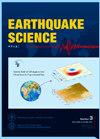Quantifying of spatio-temporal variations in the regional gravity field and the effectiveness of earthquake prediction: A case study of MS ≥ 5.0 earthquakes in the Sichuan-Yunnan region during 2021–2024
IF 4.1
4区 地球科学
Q3 Earth and Planetary Sciences
引用次数: 0
Abstract
Since the 1975 MS7.3 Haicheng earthquake, spatio-temporal variations in the gravity field have attracted much attention as potential earthquake precursors. Recent technical advances in terrestrial gravity observation, along with the construction of a high-precision mobile gravity network covering Chinese mainland, have positioned temporal gravity variations (GVs) as an important tool for clarifying the signal characteristics and dynamic mechanisms of crustal sources. Reportedly, crustal mass transfer, which is affected by stress state and structural environment, alters the characteristics of the regional gravity field, thus serving as an indicator for locations of moderate to strong earthquakes and a seismology-independent predictor for regions at risk for strong earthquakes. Therefore, quantitatively tracking time-varying gravity is of paramount importance to enhance the effectiveness of earthquake prediction. In this study, we divided the areas effectively covered by the terrestrial mobile gravity network in the Sichuan-Yunnan region into small grids based on the latest observational data (since 2018) from the network. Next, we calculated the 1- and 3-year GVs and gravity gradient indicators (amplitude of analytic signal, AAS; total horizontal derivative, THD; and amplitude of vertical gradient, AVG) to quantitatively characterize variations in regional time-varying gravity field. Next, we assessed the effectiveness of gravity field variations in predicting earthquakes in the Sichuan-Yunnan region using Molchan diagrams constructed for gravity signals of 13 earthquakes (M ≥ 5.0; occurred between 2021 and 2024) within the terrestrial mobile gravity network. The results reveal a certain correspondence between gravity field variations and the locations of moderate and strong earthquakes in the Sichuan-Yunnan region. Furthermore, the 3-year AAS and AVG outperform the 3-year THD in predicting subsequent seismic events. Notably, the AAS and AVG showed large probability gains prior to the MS6.8 Luding earthquake, indicating their potential for earthquake prediction.
区域重力场时空变化量化与地震预报效果研究——以2021-2024年川滇地区MS≥5.0地震为例
自1975年海城MS7.3地震以来,重力场的时空变化作为潜在的地震前兆受到了广泛关注。近年来地球重力观测技术的进步,以及覆盖中国大陆的高精度移动重力网络的建设,使时间重力变化(GVs)成为揭示地壳震源信号特征和动力机制的重要工具。据报道,地壳质量传递受应力状态和构造环境的影响,改变了区域重力场的特征,因此可以作为中强震位置的指标和与地震学无关的强震危险区域的预测指标。因此,定量跟踪时变重力对提高地震预报的有效性至关重要。本研究基于川滇地区地面移动重力网最新观测数据(2018年以来),将川滇地区地面移动重力网有效覆盖区域划分为小网格。接下来,我们计算了1年和3年的GVs和重力梯度指标(分析信号振幅,AAS;总水平导数THD;和垂直梯度振幅(AVG),定量表征区域时变重力场的变化。接下来,我们利用13次地震(M≥5.0;发生在2021年至2024年之间),在陆地移动重力网络内。结果表明,川滇地区重力场变化与中、强地震的位置有一定的对应关系。此外,3年AAS和AVG在预测后续地震事件方面优于3年THD。值得注意的是,AAS和AVG在泸定6.8级地震前的概率增加较大,表明了它们在地震预测方面的潜力。
本文章由计算机程序翻译,如有差异,请以英文原文为准。
求助全文
约1分钟内获得全文
求助全文
来源期刊

Earthquake Science
GEOCHEMISTRY & GEOPHYSICS-
CiteScore
1.10
自引率
8.30%
发文量
42
审稿时长
3 months
期刊介绍:
Earthquake Science (EQS) aims to publish high-quality, original, peer-reviewed articles on earthquake-related research subjects. It is an English international journal sponsored by the Seismological Society of China and the Institute of Geophysics, China Earthquake Administration.
The topics include, but not limited to, the following
● Seismic sources of all kinds.
● Earth structure at all scales.
● Seismotectonics.
● New methods and theoretical seismology.
● Strong ground motion.
● Seismic phenomena of all kinds.
● Seismic hazards, earthquake forecasting and prediction.
● Seismic instrumentation.
● Significant recent or past seismic events.
● Documentation of recent seismic events or important observations.
● Descriptions of field deployments, new methods, and available software tools.
The types of manuscripts include the following. There is no length requirement, except for the Short Notes.
【Articles】 Original contributions that have not been published elsewhere.
【Short Notes】 Short papers of recent events or topics that warrant rapid peer reviews and publications. Limited to 4 publication pages.
【Rapid Communications】 Significant contributions that warrant rapid peer reviews and publications.
【Review Articles】Review articles are by invitation only. Please contact the editorial office and editors for possible proposals.
【Toolboxes】 Descriptions of novel numerical methods and associated computer codes.
【Data Products】 Documentation of datasets of various kinds that are interested to the community and available for open access (field data, processed data, synthetic data, or models).
【Opinions】Views on important topics and future directions in earthquake science.
【Comments and Replies】Commentaries on a recently published EQS paper is welcome. The authors of the paper commented will be invited to reply. Both the Comment and the Reply are subject to peer review.
 求助内容:
求助内容: 应助结果提醒方式:
应助结果提醒方式:


